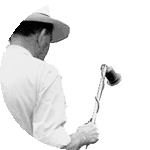
 |
||
 |
Hugh Tracey began studying African Music soon after arriving in
Zimbabwe from England in 1920.
He was the first person to record their music in the Zambezi Valley.
His reasons for doing so revolved around his love of African music
and because he wanted to ensure that their culture was saved for future awareness. |
 |
 |

Tracey´s interest in African music at a time when European colonial settlers refused to recognise that Africans had cultures (Africans were referred to as natives and supposedly only had customs), often meant that he was shunned by white settler society. The well known author, Doris Lessing, who herself was declared an illegal immigrant by the Rhodesian regime because of her outspoken criticism of colonial rule, recalls that he was generally referred to scathingly as "that man Hugh Tracey". Tracey´s greatest crime, however, was that he ate African food with Africans! Good heavens!
Recording in the field in the first half of the 20th century was no easy task. The very first recordings Hugh Tracey made were on soap! Not surprisingly, none of these have survived. He describes the cumbersome approach that he and the recording engineers had to employ-
"In addition to the various types of recording apparatus, we had,
in the early years, to provide our own electricity and this demanded
a trailer with a 240v. 50 cycle generator, a total weight of about
half a ton. To this power supply I fitted a double silencer and
a 4100 yard long line so that it could be placed out of ear-shot
behind an anthill or hut. The first year's recordings were all
on acetate discs, but in 1949 we managed to obtain one of the
first models of a studio EMI tape recorder which operated at 30
inches per second. This was so cumbersome that an extra dome had
to be fitted to the recording van in order to work it. During
the following years, with several changes of recording equipment,
both the weight and the fidelity of the tape recorders continually
improved. We changed first to a Phillips recorder and then a Danish
Lyrec, recording at 15 inches per second -- these machines recorded
the majority of the "Sound of Africa" series -- and subsequently
a Nagra. We now use the Stellavox stereo portable transistor recorder,
weighing little over nine pounds and operated by torch batteries."
from: Sound of Africa, Hugh Tracey.